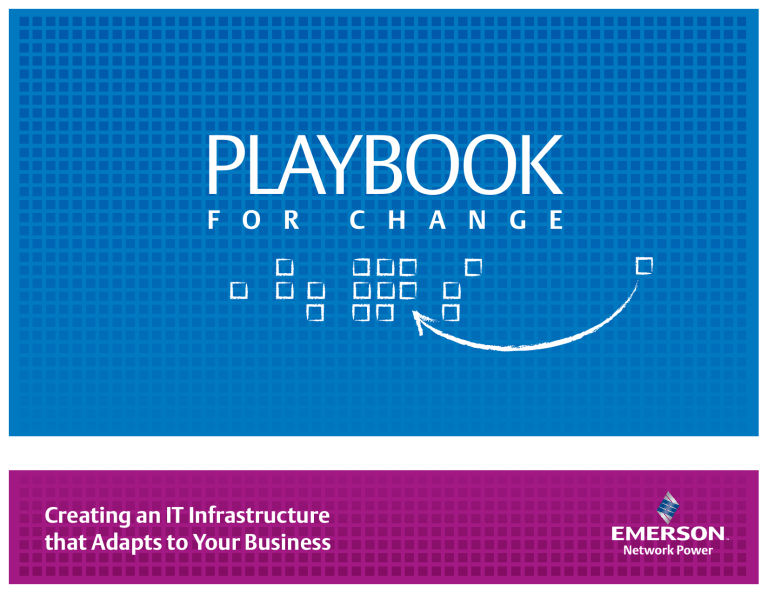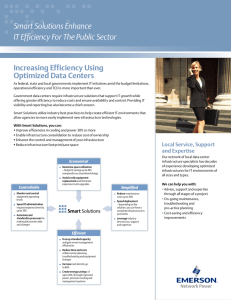PLAYBOOK F O R C H A N G... Creating an IT Infrastructure that Adapts to Your Business

PLAYBOOK
F O R C H A N G E
Creating an IT Infrastructure that Adapts to Your Business
1
Creating an IT Infrastructure that Adapts to Your Business
For decades, data centers have been over-provisioned two or even three times over in an attempt to “plan” for growth. Businesses have spent excessively to build facilities that might be able to handle potential IT needs that may arise sometime in an uncertain future.
As recently as 10 years ago, before virtualization was widely accepted, it was not unusual to see 4 watts of
UPS capacity installed for every 1 watt of IT load. To be fair, 10 years ago that may have been the only guaranteed way to ensure the investment in IT resulted in the needed capacity increases – even if that investment amounted to a massive overpay.
That isn’t the case today, although limitations to the physical infrastructure – power, cooling and space – remain. Now, instead of bumping up against imagined walls like some overzealous mime, data center managers and CIOs can measure their loads and capacity accurately, and deploy techniques and technologies to either maximize or add capacity without the massive capital investment that comes with a new data center – or be armed with enough data to go into a new build confident it’s the right choice.
But with a whole spectrum of choices available – up to and including biting the bullet and building a shiny new data center – how do forward-thinking, budget-conscious businesses make the right choice?
How do they build an IT infrastructure that can scale in every direction in order to meet uncertain future demands?
2018 or beyond (6+ years)
2017 (5 year)
2016 (4 year)
2015 (3 year)
2014 (2 year)
2013 (1 year)
2012
10.4%
12.2%
11.0%
17.1%
20.1%
22.0%
7.3%
0.0% 5.0% 10.0% 15.0% 20.0% 25.0%
Increasing power densities are going to stretch the power and cooling capacity of many existing data centers. This chart shows when surveyed data center managers expect to be impacted by data center capacity constraints. (Source: Data
Center Users’ Group Fall 2012 Survey)
Know the Scouting Report
The formula for any decision in the data center is well-established: balance capital and operational expenses as efficiently as possible without jeopardizing availability of critical applications.
Simply put, minimize capital investments unless the investment will be recovered through a reduction in operational expenses. Recovery could happen in any number of ways. For example, it could happen by increasing capacity and, in turn, business volume and revenue. Or by increasing energy efficiency and reducing operational costs related to power consumption. Or by reduction or elimination of ongoing maintenance and service. In each case, it comes down to a cost-benefit analysis.
A few questions can help establish a basic strategy for managing organizational growth and increasing
IT demand. Those questions are:
Is the entire load critical to the business?
The kneejerk reaction is “yes.” And in some cases – financial services institutions or ecommerce businesses, for example – that may be true. But even in those examples, a closer examination may reveal a different answer. Ensuring availability of all transactional functions is non-negotiable, but what about some internal IT functions or support systems? If some applications are less critical, could they be outsourced to a co-location facility or hosted in the cloud? If so, that frees up capacity within the owned data center.
Creating an IT Infrastructure that Adapts to Your Business
Even within the data center, some organizations are beginning to assign non-critical applications to separate pods with a less robust infrastructure and adjusting the expectations for availability accordingly.
The savings generated in those non-critical pods can be used elsewhere – including reinvestment in the infrastructure in more critical areas supporting high-value applications.
Is there available infrastructure capacity that isn’t being used?
This seemingly simple question tends to confound even the most IT-focused organizations. Data centers grow and evolve over time, adding servers and the power and cooling needed to support them – and all of those additions consume valuable space. The facility may or may not be virtualized – a practice that can increase efficiency but can complicate the capacity question. Eventually trying to figure out exactly what the existing infrastructure can support becomes more difficult than it should be.
Data Center
Infrastructure Tier Description
I: Basic Data Center Single path for power and cooling distribution without redundant components. May or may not have a UPS, raised floor or generator.
Availability
Supported
99.671%
II: Redundant
Components
Single path for power and cooling distribution with redundant components. Will have a raised floor, UPS and generator, but the capacity design is N+1 with a single-wired distribution path throughout.
99.741%
III: Concurrently
Maintainable
Multiple active power and cooling distribution paths, but only one path is active. Has redundant components and is concurrently maintainable. Sufficient capacity and distribution must be present to simultaneously carry the load on one path while performing maintenance on the other path.
99.982%
IV: Fault Tolerant Provides infrastructure capacity and capability to permit any planned activity without disruption to the critical load. Infrastructure design can sustain at least one worst case, unplanned failure or event with no critical load impact.
99.995%
The Uptime Institute defines four tiers of data center infrastructure availability to help organizations determine the level of investment in power required to achieve desired availability levels.
Data center infrastructure management (DCIM) technologies give data center managers the ability to understand what infrastructure systems are in their facilities, where they are, and what applications those systems support. That level of visibility – understanding where applications of various levels of criticality reside and how they’re being powered and cooled – demystifies the physical fabric of the data center and gives data center managers the power to unlock hidden capacity within their existing facilities.
How much capacity is needed – and when?
Traditional approaches to data center scalability could best be described as linear – the business is growing, IT demands will grow with it, so the data center is going to need to be able to support more applications in the future than it does now. This is how we end up with over-provisioned data centers.
They meet the availability requirement, but the initial capital investment was higher than it should have been for a facility that’s far less efficient than it could be. The organization ends up paying more up front and operationally – and that’s assuming the original infrastructure technologies remain viable when the business grows into all that extra space five or 10 years later. If it sounds nuts, it is – but it was relatively common practice as recently as 10 years ago.
Today’s technologies enable a more nuanced approach to growth and scalability, allowing businesses to invest more prudently and manage the need for more capacity – or less – as it emerges.
2
Creating an IT Infrastructure that Adapts to Your Business
Develop a Gameplan
A deep understanding of the IT load, its criticality and available capacity can help businesses develop a strategy for building a scalable IT infrastructure. Understanding that cloud or co-location services can be a viable complement to in-house
IT services, there are three key strategies for creating a more scalable infrastructure:
Use advanced technology or software to unlock existing capacity and scale up or down
Technology now enables infrastructure scalability from hour to hour. Applications that see peak usage during business hours but more or less shut down overnight do not require the same level of power and cooling support around the clock. Intelligent infrastructures can scale up and down as needed – idling a UPS, for example, when it isn’t needed and then reactivating it during peak hours. Advanced cooling solutions react in real time to changes in temperature, again scaling up or down based on activity.
Taking that control to the next level, those off-cycle infrastructure systems can be used to support other applications that might be ramping up at the same time.
Understanding these patterns and optimizing utilization rates dramatically improve facility-wide energy efficiency and helps avoid bloated data centers. Facilities experiencing regular load fluctuations but modest growth could build an efficient power and cooling infrastructure using these advanced controls.
Scale up with building blocks
The introduction of self-contained, integrated and modular power and cooling systems has had as significant an impact on the data center over the last 10 years as any server advancement. These smaller, agile technologies – including everything from row-based UPS and cooling systems to large containers with complete infrastructures – make incremental investment in infrastructure capacity possible. Growing businesses can add a row of racks along with the power and cooling to support them with little or no disruption of the existing infrastructure, or add the equivalent of a separate, small data center with a containerized solution. The only restrictions are space and budget.
Of course, those restrictions are real. In the long term, the capital expense involved in these purchases, the sacrifice in terms of operational expense – multiple systems aren’t as efficient as a single large system, and require more service – and eventually the space they consume present some real tradeoffs for incremental gains.
Technologies and Tactics to Unlock Capacity
• Cooling
- Cold-aisle containment
- Intelligent cooling controls
- Variable speed drives
- EC plug fans
- Economization
• Power
- Double conversion UPS
- Intelligent paralleling of
UPS modules
- High-efficiency transformers
- Eco-mode
- Software scalability
- Alternative high-availability
architectures
Room Costs:
Contractor, installation, engineering services
Infrastructure Equipment:
UPS, distribution, cooling, racks, fire suppression
Total CAPEX
Annual Energy Consumption:
Power & Cooling equipment energy use
5 Year OPEX
5 Year TCO
Conventional
$60,000
$105,000
$165,000
Integrated
$43,000
$109,000
$152,000
Cost Savings
$17,000
-$4,000
$13,000
% Savings
28%
-3%
8%
$8,800 $6,400 $2,400 27%
$44,000 $32,000 $12,000 27%
$209,000 $184,000 $25,000 12%
Cost analysis for conventional versus an integrated solution in an 18 kW IT deployment.
3
Creating an IT Infrastructure that Adapts to Your Business
Room Costs:
Contractor, engineering services
Conventional
$579,000
Infrastructure Equipment:
UPS, distribution, cooling, racks, fire suppression, install $315,000
Integrated
$0
$816,000
$894,000 $816,000 Total CAPEX
Annual Energy Consumption:
Power & Cooling equipment energy use
5 Year OPEX
5 Year TCO
$31,800 $22,000
Cost Savings
$579,000
-$501,000
-$78,000
$9,000
% Savings
100%
-159%
8%
29%
$155,000 $110,000 $45,000 29%
$1,049,000 $926,000 $123,000 11%
Cost analysis for conventional versus integrated solution in a 75 kW IT deployment.
Just do it
Sometimes all the short-term and in-between fixes simply delay the inevitable. If a data center has: a) reached the limits of its existing capacity, and b) exhausted its options for unlocking more, and c) run out of physical space to grow, and d) eliminated outsourcing as an option, then the time has come to build a new facility. The good news? That new data center can be built with scalability in mind, and with access to infrastructure technologies that enable intelligent, efficient IT growth that meets current and future business needs.
Study the game film
Whatever path is chosen, it’s important to measure the results to inform future decisions and investments.
Room Costs:
Contractor, engineering services, installation
Infrastructure Equipment:
UPS, distribution, cooling, racks, fire suppression
Total CAPEX
Annual Energy Consumption:
Power & Cooling equipment energy use
Conventional
$515,000
$415,000
$930,000
Integrated
$459,000
$391,000
$850,000
Cost Savings
$56,000
$24,000
$80,000
% Savings
1%
-6%
9%
$63,600 $46,600 $17,000 27%
5 Year OPEX
5 Year TCO
$318,000 $233,000 $85,000 27%
$1,248,000 $1,083,000 $165,000
Cost analysis for conventional versus integrated configuration in a 160 kW IT deployment.
13%
4
About Emerson Network Power
Emerson Network Power provides efficient, reliable critical infrastructure solutions for data centers, communications networks, healthcare and industrial facilities around the world. With proven innovations in power, thermal management, IT solutions and a global network of service experts covering more than 150 countries, we make the future of communications and information technology possible.
We understand how data center infrastructure is becoming more complex at almost every level, and more essential to the success of the business than ever before. Get the insight and resources you need to lead your organization into the future at EmersonNetworkPower.com/CIOtopics.
EmersonNetworkPower.com
Emerson Network Power and the Emerson Network Power logo are trademarks and service marks of Emerson
Electric Co. All other trademarks are the property of their respective owners. ©2013 Emerson Electric Co.



